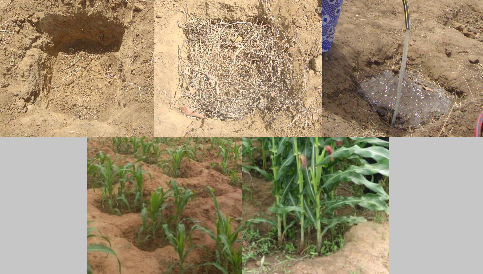
Zaï - Wikipedia
In the past generation, there has been a bit of a revolution in the agricultural practices in marginal Sahel lands. There is a traditional agricultural technique called Zai, which is simple on its face: dig pits where you plant, in order to collect water before it runs off the soil completely. I haven't found just how old this technique is, but it is consistently described as 'traditional' so I'm going to assume it has been around an arbitrarily long time. What modern Sahel farmers have done is introduce a few refinements:
- Place rows of small stones along the contours of the land, to slow water further, allowing even more to soak in during the rainy season (think of them as very small weirs)
- Fertilize the pits with manure and compost (it boggles my mind that this is an innovation)
- Planting trees amongst the crops, to act as windbreaks and help form microclimates
- Nurture populations of termites, who tunnel around the various zai pits and irrigate and loosen the soil
- Dig the pits before the rainy season, when there is plenty of labor
All of this combines to produce yields of 1,200 kg/hectare (comparable to Italy during the Roman Empire, or just about 2/3 of Roman Egypt's productivity) all with brute manual labor (if you watch the video, one of the more innovative farmers is using animal labor), in some of the most degraded soil on Earth. All with no technology that wasn't used prior to the neolithic. In fact, it seems that the more degraded the soil, the faster the manure breaks down into fertile soil.
Before I get ahead of myself, I will add the caveat that I've watched a few documentaries and read a bit on this, and it seems too good to be true, so if there's any counter evidence, I'll put my utterly unsurprised face on. It does seem that one of the biggest limitations is the available manure, which can be somewhat scarce (esp when one considers that these societies often use it for fuel). Of course, these techniques pale in comparison to modern industrialized agriculture, and I can't wonder what these farmers could do with a hand held auger and a can of gasoline. Still, all these concerns aside, 1,200 kg/ha is nothing to sneeze at, especially when one considers the feedback loop that can occur, as more crops mean you can feed more livestock. Further, when forestry is incorporated into the technique, the resulting microclimates can hold the gradually growing desert at bay, and possibly even reclaim some of its southern reaches.
So, let us assume that at some point in antiquity (lets just say around the first century, BC or AD, your pick), zai farming techniques are already being used, and some enterprising farmers stumble across doing what I'll call modern zai planting. Give it another few centuries to get refined and spread out across the region, but before the fall of Rome, the Sahel states are producing comparable agricultural yields to the more fertile parts of the Mediterranean. This means a larger, more productive society, likely quite richer, as well. Especially when the trans-Sahara trade routes open up.
Outside of the scope of my interest, I do have to think that these techniques could be used in other regions, as well.